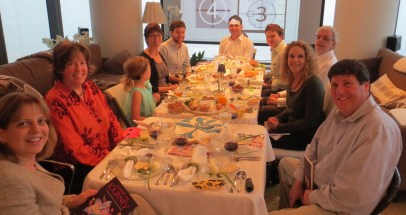This week is framed by the unfulfilled promises of liberation.
On April 16, we celebrated Emancipation Day, which marks the anniversary of President Lincoln’s signing the Compensated Emancipation Act of 1862, which freed the over 3,000 enslaved individuals who resided in Washington, D.C.
On April 22, which is also the 14th of Nissan, we will sit at our Seder tables to commence our annual Passover festival which marks not only the historic liberation of our people from Egyptian oppression, but also the beginning of our obligation to insure none in the world suffer similar degradation and abuse.
Our Passover meal ends with the hope, “Next year in Jerusalem! Next year may all be free!” We understand it is our obligation to rise up from our Seder and work for that great liberation of humanity which is not yet complete. For those who marked Emancipation Day, we recognize that—in a society still roiled by racial injustice—the promise of American Emancipation is likewise not yet fulfilled.
It is our work to bring to light the Jewish hope, and the American dream, of enduring freedom for all. Passover teaches us that the opposite of freedom is oppression; we know in American that the antithesis of living free is being incarcerated. We also know that our country today suffers—disproportionately in the case of our Black brothers and sisters—from the plague of Mass Incarceration. That is why we, as a Reform Movement and Reform Rabbis, have banded together to advocate the passage of the bipartisan Sentencing Reform and Corrections Act [S. 2123] in this year’s Congress.
Fighting for the passage of S. 2123 has been interesting for me as a resident of Illinois. One of my Senators, Richard Durbin [D-IL], is an original co-sponsor of the bill. My other Senator, Mark Kirk [R-IL], has long been viewed as a key moderate who might ultimately come out in support of the bill. Our job was to turn the possibility of Kirk’s potential support for this bill into his committed support.
Our work began in January, the Friday before Rev. Martin Luther King Day. Rabbi Ari Margolis and I met with Senator Kirk’s representatives in his Chicago office, and explained our movement’s support for this needed legislation. The following Tuesday, over 500 Reform Jews—inspired by their rabbis—called into Kirk’s office to add their voices to those who wished to see S. 2123 become the law of our land.
But January brought no word of endorsement or support, we took further action. The Leadership Conference on Civil and Human Rights organized a local press conference at which I spoke on behalf of the Reform Movement and reminded our Senator that, “Mercy, redemption and rehabilitation are just as much part of a just society as punishment.” [http://thehill.com/regulation/legislation/267347-illinois-residents-push-sen-kirk-to-support-criminal-justice-reform] Still, we hear little from Capitol Hill.
Last week, I travelled to Washington, D.C., as part of our bi-annual meetings of our Commission on Social Action. Our meetings ended on Tuesday with a trip up to the Hill, where we gathered in state Caucuses to lobby on behalf of S. 2123. Together, Rabbi Shoshana Conover and Deborah Kadin and I prepared for what we feared would be a contentious meeting in Kirk’s offices: too much time had passed for us not to receive an answer. As we sat with Gregory Tosi, the Senator’s lead counsel, I honestly felt like we would walk away defeated. Boy was I wrong.
Instead, as we finished advocating for our cause, Greg shared the following with us: “You’ll be happy to hear—and you’re the first to hear—that the Senator decided today to become a co-sponsor of the bill.” That direct. That plain. After months, the victory we sought… a first small win on the campaign for much more.
We left the Hart Office building delighted. I thought I was the one with good fortune—I also ran into colleagues Matthew Cutler and Michael Latz, who were lobbying with the Jubilee USA network for relieving global poverty. It was my colleague Rabbi Conover who had the best luck: she ran into Senator Kirk himself, while he was on the way to a press conference to announce his support for S. 2123. On behalf of all of us, she thanked him for his vote.
As we dwell in a season of unfulfilled dreams, I am fully aware that this victory is small. Next, we need to ensure S. 2123 makes its way to the Senate floor. Then we will likely need to fight for its passage. And then, the problems of Mass Incarceration won’t evaporate; they will only be mitigated. Dr. King taught that the moral arc of the universe is long, and we need to be in this for the long struggle if we want to make sure that arc bends towards justice.
I left Capitol Hill last week, a few Days before Emancipation day and a week prior to Passover, feeling just as I do every year when the Seder comes to an end: I’m appreciative of the strides we’ve made towards liberation for all, but aware that we have a lot more marching to do to pass everyone through the split sea to the Land of Promise.
—
Rabbi Seth Limmer serves Chicago Sinai Congregation. He is also the Social Justice committee chair for the CCAR.
Read more about the Commission on Social Action and Rabbis Organizing Rabbis trip to Washington D.C.










